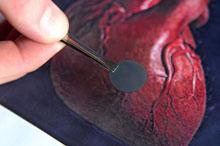Nanotube patch helps heal the heart
May 20, 2011

Brown University researchers have created a tiny patch made out of carbon nanotubes that tests show restores areas that have been damaged, such as from a heart attack (credit: Frank Mullin, Brown University)
Carbon nanotubes that mimic natural tissue and can regenerate heart cells in a dish have been created by researchers at Brown University.
The material compensates for nerve cells in the heart’s wall and a special class of cells that spontaneously expand and contract, keeping the heart beating in perfect synchronicity, which are lost forever after a heart attack.
The conductive patch mimics the rough surface of natural tissue. The carbon nanofibers work well because they are excellent conductors of electrons, performing the kind of electrical connections the heart relies upon for keeping a steady beat. The scaffold is elastic and durable, and can thus expand and contract much like heart tissue.
The approach, if successful, would help millions of people. In 2009, some 785,000 Americans suffered a new heart attack linked to weakness caused by the scarred cardiac muscle from a previous heart attack, according to the American Heart Association.
The scientists want to tweak the scaffold pattern next to better mimic the electrical current of the heart, as well as build an in-vitro model to test how the material reacts to the heart’s voltage and beat regime.